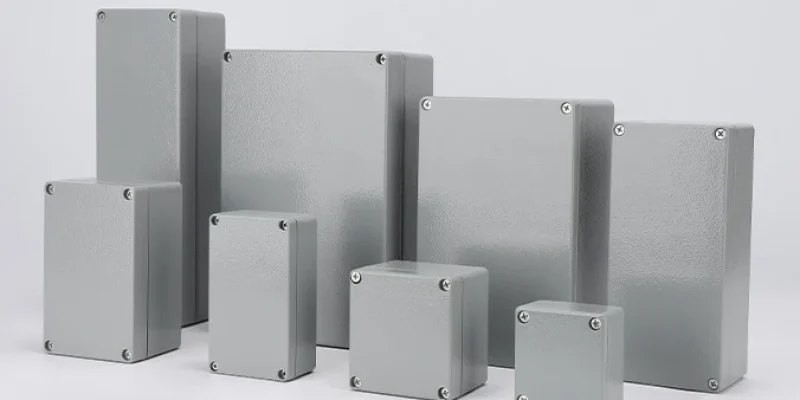Junction boxes are essential electrical components that come in various types, including metal and plastic, round and square, and specialized designs for specific applications such as ceiling fans or outdoor use. These boxes protect wire connections, organize electrical systems, and vary in size, shape, and material to suit different installation needs and environmental conditions.
Material-Based Junction Boxes
Junction boxes are available in various materials, each offering distinct advantages for different applications. The two primary categories of material-based junction boxes are:
Metāla sadales kārbas:
- Typically made of galvanized steel or aluminum
- Offer superior durability and fire resistance
- Ideal for industrial settings and areas requiring extra protection
- Provide better heat dissipation for high-current applications
- Often used in commercial and industrial installations
Plastmasas sadales kārbas:
- Usually constructed from PVC or other thermoplastic materials
- Lightweight and easy to install
- Resistant to corrosion and moisture, making them suitable for outdoor use
- More affordable than metal alternatives
- Commonly used in residential settings and areas with lower electrical demands
When selecting a junction box, consider factors such as the installation environment, local electrical codes, and specific project requirements to determine the most appropriate material.
Design-Based Junction Boxes
Junction boxes come in various designs to accommodate different installation requirements and electrical needs. Here’s an overview of the main design-based junction box types:
| Dizains | Characteristics and Uses |
|---|---|
| Rectangular | Standard shape for wall outlets and switches, versatile for most residential applications |
| Round/Octagonal | Commonly used for ceiling fixtures, light fixtures, and smoke detectors |
| Kvadrāts | Larger capacity for multiple wires, often used in commercial settings or for ceiling fans |
| Weatherproof | Designed for outdoor use with sealed covers to protect against moisture and environmental factors |
| Surface-mounted | Installed on the surface of walls or ceilings, often used in retrofitting or industrial settings |
| Flush-mounted | Recessed into walls or ceilings for a sleek appearance, typical in new construction |
Each design serves specific purposes, from accommodating different types of electrical devices to providing protection in various environments.
Special Purpose Junction Boxes
Special purpose junction boxes are designed to meet specific electrical requirements or environmental conditions. Here’s a list of some specialized junction boxes and their unique features:
- Outdoor Junction Boxes: Weather-resistant and waterproof to protect against moisture and environmental factors.
- CCTV Junction Boxes: Specifically designed to house and protect CCTV camera connections and equipment.
- Conduit Boxes: Designed to connect and organize multiple conduit runs.
- Maintenance-Free Junction Boxes: Sealed units that require minimal upkeep after installation.
- Explosion-Proof Junction Boxes: Constructed to contain electrical sparks and prevent ignition of surrounding flammable gases or vapors.
These specialized junction boxes cater to specific needs, ensuring proper protection and functionality in various challenging environments and applications.
Multi-Gang Junction Boxes
Multi-gang junction boxes are designed to accommodate multiple electrical devices in a single location, offering versatility and space efficiency in electrical installations. These boxes are particularly useful in areas that require multiple switches, outlets, or a combination of devices. Here’s an overview of multi-gang junction boxes:
- 2-Gang Boxes: Accommodate two electrical devices side by side, commonly used for dual light switches or outlet combinations.
- 3-Gang Boxes: Hold three devices in a row, ideal for complex lighting controls or multiple outlet configurations.
- 4-Gang Boxes: Provide space for four devices, used in areas requiring extensive electrical control or power access.
Multi-gang boxes are available in both metal and plastic varieties, allowing for flexibility in different installation environments. When selecting a multi-gang box, it’s crucial to consider the total number of wires and connections to ensure adequate space and comply with electrical codes.


